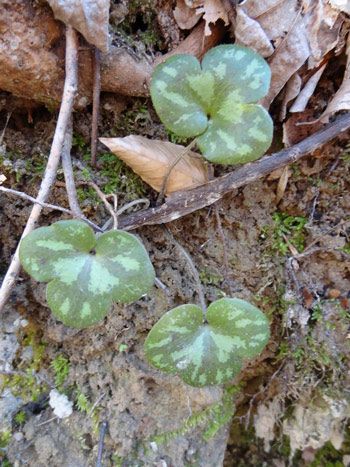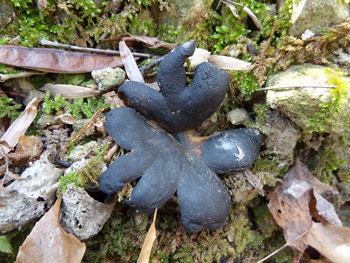Getting lost in the winter woods

Evergreen, three-lobed hepatica leaves are unmistakable. Photo by Brian Stokes
Flora Columnist
Last week woods-walking companion Tony Blanford took the lead to introduce Brian Stokes and me to his favorite “secret forest†of legendary oaks and beeches. Part of the goal was to get lost, and Tony succeeded in getting us totally turned around, leaving us with the unusual satisfying feeling of, “Well now, we may really be lost.â€
Though Tony’s “secret forest†was a rather large acreage, we comforted ourselves with the thought that wild areas hereabouts are so contained that if we simply walk in a straight path, we’ll eventually emerge on some, hopefully familiar, road.
The real challenge then became walking a straight unmarked route through the forest.
We did eventually emerge from the forest right behind our parked vehicle. We humorously made note that our walk into and out of the woods described a circular straight route.
Brian and Tony continued to humor my preference for winter as my favorite outdoor season. And they remained keen to continue appreciating the diversity of tree bark. At one spot we enjoyed noting the differences of bark patterns of our three local pines.
The flat, smooth bark plates of loblolly pine, Pinus taeda, contrast with the bark plates of shortleaf pine, Pinus echinata, that exhibit distinctive depressed pinpoints, called resin ducts. The smaller bark plates of the Virginia scrub pine, Pinus virginiana, are less organized in appearance, often being scaly or otherwise peeling off the trunk. However, one needs to study other characteristics of leaf and cone to accurately recognize these three pines; perhaps we’ll take a closer look at these in a future Flora story.
Beneath Tony’s giant trees we delighted in finding numerous surprises on the forest floor. What Brian now calls the “love of his life†were countless specimens of the three-lobed, evergreen liverleaf, Hepatica (Anemone) americana. A good population of hepaticas calls for a return visit from mid-February through early March to see clusters of nickel-size, clear-blue flowers. With this year’s warm winter sunshine, however, expect to see flowers sooner.

Finding an earthstar on a woods walk is special. Photo by Brian Stokes
Also note that finding a sizable population of hepaticas indicates the site will likely reward the woods walker with a diversity of wildflowers during the spring.
For me, as much fun as getting lost was the unexpected find of several earthstars scattered along the creek slopes. Being on uncertain footing with my fungi identifications, I will simply describe earthstars as a type of puffball mushroom. The fine specimens we found, captured by Brian’s camera, were hardened, ebony-colored star shapes from which the puffball portion had discharged its spores and disintegrated sometime in the fall. Most of the earthstars were barely visible scattered in the leaf litter, but two on a mossy rock surface were easy to spot and simply spectacular!
I hope you are taking weekly woods walks, enjoying the beauty of trees in the winter and discovering other botanical surprises along the way. Search for your own “secret forest†in which to get lost, knowing that if you succeed, you won’t be lost for long. And take care to have a friend or two accompany you!
Email Ken Moore at flora@carrborocitizen.com. Find previous Ken Moore Citizen columns at The Annotated Flora (carrborocitizen.com/flora).
Comments are closed.


I’ve been reading your blog for awhile now – makes me so homesick for NC! If it’s not too much bother, you might want to consider submitting a post or two to the Berry Go Roundbotanical blog carnival.